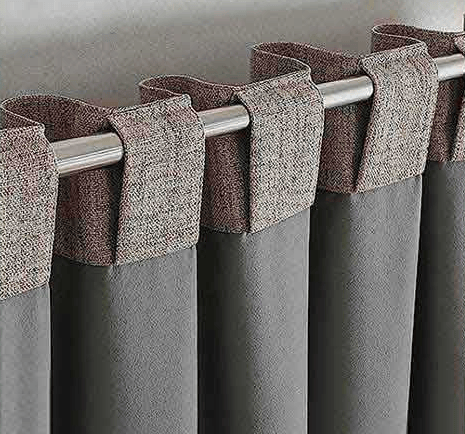The Timeless Elegance of Linen Curtains: A Guide to Styles and Applications
11/28/20245 min read


Introduction to Linen Curtains
Linen curtains have become an increasingly popular choice in modern interior design, known for their unique properties and timeless elegance. Linen, a natural fabric derived from the flax plant, possesses distinct characteristics that set it apart from synthetic materials. Its texture is not only pleasing to the eye but also adds depth and warmth to any space. The breathability of linen promotes air circulation, making it an ideal selection for various climates, while its natural fibers allow for an aesthetically appealing drape.
The history of linen as a favored material for home décor dates back centuries. Ancient civilizations valued linen for its durability and functionality, often using it in their garments and household items. Over time, linen has remained synonymous with luxury and sophistication, thus earning its place in both classic and contemporary design. Today, as homeowners seek materials that reflect sustainability and natural beauty, linen curtains have witnessed a dramatic resurgence.
One of the primary advantages of linen curtains is their ability to filter light effectively while maintaining a level of privacy. When natural light filters through the soft, textured fabric, it creates a serene ambiance that enhances the overall aesthetic of any room. Furthermore, linen curtains are known for their elegant appearance, which can transform a mundane space into a refined haven. They complement various design styles, ranging from rustic and farmhouse to minimalist and Scandinavian, making them a versatile choice for homeowners seeking a cohesive look.
In conclusion, the appeal of linen curtains is rooted in their unique properties, rich history, and aesthetic versatility. By choosing linen, homeowners add not only elegance but also functionality to their interiors, ensuring that these curtains remain a timeless addition to any room.
Popular Styles of Linen Curtains
Linen curtains have long been celebrated for their unique ability to blend functionality with aesthetic appeal. Among the numerous styles available, sheer linen curtains stand out for their light and airy quality. These curtains allow natural light to filter through while providing a level of privacy, making them ideal for living spaces and bedrooms where ambiance is paramount. The soft texture of sheer linen can soften harsh edges in a room, creating a tranquil atmosphere.
On the other end of the spectrum, blackout linen curtains offer a solution for those requiring complete darkness, such as during midday naps or for bedrooms that face busy streets. These curtains are typically lined to block out sunlight effectively, while still offering the inherent beauty and texture of linen. Their versatility allows them to fit seamlessly into any décor, from traditional to contemporary settings.
For a more modern approach, panel curtains made from linen can introduce a chic element to a room. These curtains typically consist of large fabric panels that can be drawn across the window, allowing for easy adjustment to light levels and privacy. They are available in various colors and patterns, ensuring that homeowners can find an option that complements their interior design style.
Additionally, tie-top designs have emerged as a popular choice among those looking for a laid-back, rustic feel. This style consists of curtains that are tied to a rod with fabric strips, lending a charming and casual vibe perfect for farmhouse and cottage aesthetics. The versatility of linen curtains extends beyond just styles; they can also be found in an array of colors and textures, allowing for customization to suit diverse preferences and room aesthetics.
In summary, the diverse styles of linen curtains—be they sheer, blackout, panel, or tie-top—cater to various decorative needs, enhancing both traditional and contemporary spaces while showcasing the timeless elegance of linen fabrics.
Choosing the Right Linen Curtains for Your Space
When selecting linen curtains for your home, several factors need to be considered to ensure that the chosen window treatments enhance the overall aesthetic of each room. Begin by evaluating the color scheme of the space. Linen curtains come in a myriad of colors, from neutral tones to vibrant hues. Selecting shades that complement or contrast with your existing decor can create a pleasing visual balance. For instance, lighter colors can invite a sense of airiness to a small room, while deeper shades can add sophistication and warmth to larger spaces.
Next, consider the weight of the linen fabric. Heavier linen is ideal for areas requiring more privacy or insulation, while lighter fabrics work well in locations where a softer, breezy ambiance is desired. The weight of the fabric may also influence how well the curtains drape, impacting the overall style. For example, flowing linen is perfect for creating a casual, relaxed atmosphere, while structured designs suit more formal settings.
The length of the curtains should also be taken into account. Floor-length curtains can add a dramatic touch and enhance the perception of height, whereas shorter curtains are often more suited for kitchens or casual spaces where practicality is vital. Additionally, measuring windows accurately is crucial. Use a metal tape measure to determine the width and height of your windows, accounting for any space needed for curtain rods and brackets. This information will guide you in selecting the appropriate sizes.
Lastly, the choice of hardware may also play a significant role in the installation and style of the linen curtains. Opting for decorative rods or simple brackets can enhance the overall design. By considering these aspects—color, fabric weight, length, measurements, and hardware—homeowners can confidently choose the perfect linen curtains to complement their decor seamlessly.
Caring for Linen Curtains: Maintenance and Care Tips
Linen curtains are a beautiful addition to any home, bringing both style and functionality. To preserve their natural elegance and ensure longevity, proper maintenance is essential. When it comes to washing linen curtains, it is recommended to follow the manufacturer's instructions. Typically, cold or lukewarm water is best to prevent shrinkage and maintain color. It is advisable to use a gentle detergent, as harsh chemicals can damage the fibers. For heavily soiled linen curtains, a mild stain remover can be applied before washing.
When drying, avoid high heat settings, as they can cause linen to become stiff. Instead, air drying is preferable. If using a dryer, select a low heat setting and remove the curtains while slightly damp to minimize wrinkles. To maintain their natural soft texture, consider line drying or rolling the curtains in a towel to eliminate excess moisture. This technique will help preserve the linen's integrity while reducing the need for ironing.
To prevent wrinkles, it is beneficial to hang linen curtains immediately after washing, as folding them can create creases. For those already wrinkled, steaming is a gentle method to remove wrinkles without harsh treatment. Maintaining the fabric's original properties can also be enhanced by regularly brushing the curtains with a soft bristle brush, which helps to lift dust and maintain their fresh appearance.
In terms of cleaning frequency, it is recommended to clean linen curtains every six months, but this can vary based on usage and exposure to sunlight. Areas prone to high sunlight may require more frequent washing to combat fading. By adhering to these maintenance tips, linen curtains can remain a stunning, long-lasting feature of any room.
Curtains&Fabrics
Design,production,sales,service in curtain fabrics&curtians.
Quality
Products
sales01@anytextile.com
+8615968501933
© 2024. SHAOXING LEYAO IMPORT AND EXPORT CO.LTD All rights reserved.
